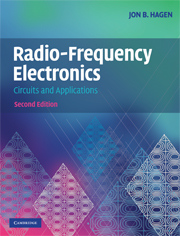Book contents
- Frontmatter
- Contents
- Preface
- 1 Introduction
- 2 Impedance matching
- 3 Linear power amplifiers
- 4 Basic filters
- 5 Frequency converters
- 6 Amplitude and frequency modulation
- 7 Radio receivers
- 8 Suppressed-carrier AM and quadrature AM (QAM)
- 9 Class-C, D, and E Power RF amplifiers
- 10 Transmission lines
- 11 Oscillators
- 12 Phase lock loops and synthesizers
- 13 Coupled-resonator bandpass filters
- 14 Transformers and baluns
- 15 Hybrid couplers
- 16 Waveguide circuits
- 17 Small-signal RF amplifiers
- 18 Demodulators and detectors
- 19 Television systems
- 20 Antennas and radio wave propagation
- 21 Radar
- 22 Digital modulation techniques
- 23 Modulation, noise, and information
- 24 Amplifier and oscillator noise analysis
- 25 The GPS Navigation system
- 26 Radio and radar astronomy
- 27 Radio spectrometry
- 28 S-parameter circuit analysis
- 29 Power supplies
- 30 RF test equipment
- Index
- References
7 - Radio receivers
Published online by Cambridge University Press: 05 June 2012
- Frontmatter
- Contents
- Preface
- 1 Introduction
- 2 Impedance matching
- 3 Linear power amplifiers
- 4 Basic filters
- 5 Frequency converters
- 6 Amplitude and frequency modulation
- 7 Radio receivers
- 8 Suppressed-carrier AM and quadrature AM (QAM)
- 9 Class-C, D, and E Power RF amplifiers
- 10 Transmission lines
- 11 Oscillators
- 12 Phase lock loops and synthesizers
- 13 Coupled-resonator bandpass filters
- 14 Transformers and baluns
- 15 Hybrid couplers
- 16 Waveguide circuits
- 17 Small-signal RF amplifiers
- 18 Demodulators and detectors
- 19 Television systems
- 20 Antennas and radio wave propagation
- 21 Radar
- 22 Digital modulation techniques
- 23 Modulation, noise, and information
- 24 Amplifier and oscillator noise analysis
- 25 The GPS Navigation system
- 26 Radio and radar astronomy
- 27 Radio spectrometry
- 28 S-parameter circuit analysis
- 29 Power supplies
- 30 RF test equipment
- Index
- References
Summary
In this chapter we will be mostly concerned with the sections of the receiver that come before the detector, sections that are common to nearly all receivers: AM, FM, television, cell phones, etc. Basic specifications for any kind of radio receiver are gain, dynamic range, sensitivity and selectivity, i.e., does a weak signal at the selected frequency produce a sufficiently strong and uncorrupted output (audio, video, or data) and does this output remain satisfactory in the presence of strong signals at nearby frequencies?
Sensitivity is determined by the noise power contributed by the receiver itself. Usually this is specified as an equivalent noise power at the antenna terminals. Selectivity is determined by a bandpass-limiting filter and might be specified as “3 dB down at 2 kHz from center frequency and 20 dB down at 10 kHz from center frequency.” (Receiver manufacturers usually do not specify the exact bandpass shape.)
Amplification
Let us consider how much amplification is needed in ordinary AM receivers. One milliwatt of audio power into a typical earphone produces a sound level some 100 dB above the threshold of hearing. A barely discernable audio signal can therefore be produced by −100 dBm (100 dB below 1 mW or 10–13 watts). Let us specify that a receiver, for comfortable earphone listening, must provide 50 dB more than this threshold of hearing, or 10–8 watts.
- Type
- Chapter
- Information
- Radio-Frequency ElectronicsCircuits and Applications, pp. 67 - 76Publisher: Cambridge University PressPrint publication year: 2009
References
- 1
- Cited by



